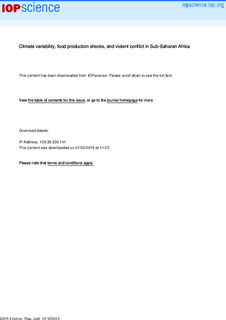| dc.contributor.author | Buhaug, Halvard | |
| dc.contributor.author | Benjaminsen, Tor A | |
| dc.contributor.author | Sjaastad, Espen Olav | |
| dc.contributor.author | Theisen, Ole Magnus | |
| dc.date.accessioned | 2016-02-01T11:45:50Z | |
| dc.date.accessioned | 2016-03-18T09:56:57Z | |
| dc.date.available | 2016-02-01T11:45:50Z | |
| dc.date.available | 2016-03-18T09:56:57Z | |
| dc.date.issued | 2015 | |
| dc.identifier.citation | Environmental Research Letters 2015, 10:125015(12) | nb_NO |
| dc.identifier.issn | 1748-9326 | |
| dc.identifier.uri | http://hdl.handle.net/11250/2382471 | |
| dc.description.abstract | Earlier research that reports a correlational pattern between climate anomalies and violent conflict routinely refers to drought-induced agricultural shocks and adverse economic spillover effects as a key causal mechanism linking the two phenomena. Comparing half a century of statistics on climate variability, food production, and political violence across Sub-Saharan Africa, this study offers the most precise and theoretically consistent empirical assessment to date of the purported indirect relationship. The analysis reveals a robust link between weather patterns and food production where more rainfall generally is associated with higher yields. However, the second step in the causal model is not supported; agricultural output and violent conflict are only weakly and inconsistently connected, even in the specific contexts where production shocks are believed to have particularly devastating social consequences. Although this null result could, in theory, be fully compatible with recent reports of food price-related riots, it suggests that the wider socioeconomic and political context is much more important than drought and crop failures in explaining violent conflict in contemporary Africa. | nb_NO |
| dc.language.iso | eng | nb_NO |
| dc.publisher | IOP Publishing | nb_NO |
| dc.relation.uri | http://iopscience.iop.org/article/10.1088/1748-9326/10/12/125015/meta;jsessionid=C6F63EE5ACAE66BD24BC997394F887CA.c4.iopscience.cld.iop.org | |
| dc.rights.uri | http://creativecommons.org/licenses/by/3.0/ | |
| dc.title | Climate variability, food production shocks, and violent conflict in Sub-Saharan Africa | nb_NO |
| dc.type | Peer reviewed | nb_NO |
| dc.type | Journal article | en_GB |
| dc.date.updated | 2016-02-01T11:45:49Z | |
| dc.source.volume | 10:125015 | nb_NO |
| dc.source.journal | Environmental Research Letters | nb_NO |
| dc.source.issue | 12 | nb_NO |
| dc.identifier.doi | 10.1088/1748-9326/10/12/125015 | |
| dc.identifier.cristin | 1306198 | |
| dc.description.localcode | Creative Commons Attribution 3.0 | nb_NO |

